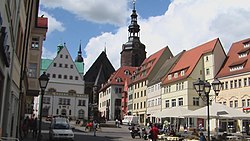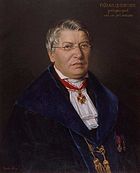Eisleben

Multi tool use
Eisleben | ||
|---|---|---|
 | ||
| ||
Location of Eisleben | ||
 Eisleben Show map of Germany  Eisleben Show map of Saxony-Anhalt | ||
| Coordinates: 51°31′N 11°33′E / 51.517°N 11.550°E / 51.517; 11.550Coordinates: 51°31′N 11°33′E / 51.517°N 11.550°E / 51.517; 11.550 | ||
| Country | Germany | |
| State | Saxony-Anhalt | |
| District | Mansfeld-Südharz | |
| Government | ||
| • Mayor | Jutta Fischer (SPD) | |
| Area | ||
| • Total | 143.81 km2 (55.53 sq mi) | |
| Elevation | 114 m (374 ft) | |
| Population (2017-12-31)[1] | ||
| • Total | 23,651 | |
| • Density | 160/km2 (430/sq mi) | |
| Time zone | CET/CEST (UTC+1/+2) | |
| Postal codes | 06295 | |
| Dialling codes | 03475, 034773, 034776 | |
| Vehicle registration | MSH, EIL, HET, ML, SGH | |
| Website | www.eisleben.eu | |
| UNESCO World Heritage Site | |
|---|---|
| Part of | Luther Memorials in Eisleben and Wittenberg |
| Includes |
|
| Criteria | Cultural: (iv)(vi) |
| Reference | 783 |
| Inscription | 1996 (20th Session) |
| Area | 0.20 ha (22,000 sq ft) |
| Buffer zone | 1.93 ha (208,000 sq ft) |
Eisleben is a town in Saxony-Anhalt, Germany. It is famous as the hometown of Martin Luther; hence, its official name is Lutherstadt Eisleben. As of 2015, Eisleben had a population of 24,198. It lies on the Halle–Kassel railway.
Eisleben is divided into old and new towns (Altstadt and Neustadt), the latter of which was created for Eisleben's miners in the 14th century.
Eisleben was the capital of the district of Mansfelder Land and is the seat of the Verwaltungsgemeinschaft ("collective municipality") Lutherstadt Eisleben.
Contents
1 History
2 Helfta
3 Martin Luther
4 Historical Population
5 People
6 Twinning
7 References
8 External links
History
Eisleben was first mentioned in 997 as a market called Islebia, and in 1180 as a town. The counts of Mansfeld governed the area until the 18th century. During the Protestant Reformation, Count Hoyer VI of Mansfeld-Vorderort (1477–1540) remained loyal to his Catholic faith, but the family's Mittelort and Hinterort branches sided with Martin Luther, who ended up dying in Eisleben, as discussed below. The German Peasants' War devastated the area, about a century before the Thirty Years War. Count Albert VII of Mansfeld-Hinterort (1480–1560) signed the Protestant Augsburg Confession in 1530 and joined the Schmalkaldic League, a defensive confederation of Protestant princes which ultimately lost the Schmalkaldic War over Saxony to the forces of Emperor Charles V but gained Lutheranism's recognition as an official religion within the Holy Roman Empire, letting princes determine the official religion within their lands.
After the Peace of Augsburg in 1555, the Countess of Mansfield, Agnes von Mansfeld-Eisleben (a Protestant canonness at the Abbey of Gerresheim to the east) converted Gebhard Truchsess von Waldburg, the Archbishop-Elector of Cologne to Calvinism. Their marriage and his declaration of religious parity throughout his lands caused another round of religious war, the Cologne War. The couple fled numerous times through various German states before Gerhard relinquished his claims in 1588. He died and was buried in Strassbourg in 1601, having failed in his attempt to convert his electorate into a dynasty. His lady (who could not return to the convent) came under the protection of the Dukes of Württemberg and died in 1601, terminating the family's Mittelort branch.
In 1574, the surviving Mansfeld counts Hans Hoyer, Hans Georg, Hans Albrecht and Bruno concluded an agreement with the Elector of Saxony to repay the family's extensive debts, but some properties were forfeited by 1579 anyway. The Hinterort branches died out in 1666, but the Mansfeld-Vorderort line lasted until 1780, when it too became extinct and Eisleben came directly under the Electorate of Saxony. After the Napoleonic Wars ended, the Vienna Congress assigned Eisleben to the Kingdom of Prussia, which had long been allied with House of Welf which held the Duchy of Magdeburg, and after secularization in 1680 was administered by the Elector of Brandenburg.
The Prussian Province of Saxony became part of the Free State of Prussia after World War I. It was the scene of fighting during the March Action in 1921.
After World War II, Eisleben became part of the new state of Saxony-Anhalt (with Magdeburg as its capitol), part of the German Democratic Republic (GDR) until Germany's reuinification in 1990.
On 6 June 1927, American aviator Clarence D. Chamberlin landed in a wheat field outside Eisleben, completing the first transatlantic passenger flight (Charles Albert Levine was the passenger), and breaking Charles Lindbergh's distance record that set only two weeks earlier in Paris, France.
Helfta

Modern accommodation for nuns, Helfta Convent (Lutherstadt Eisleben).
The Counts of Mansfield in 1229 endowed a monastery for women on the grounds of their castle, then built a separate monastery at Helfta near Eisleben, which opened in 1258. Governed under either the Benedictine or Cistercian model, Helfta became known for its powerful and mystical abbesses, including Gertrude of Hackeborn, Gertrude the Great and Mechtild. However, Duke Albrecht of Brunswick destroyed the nunnery in 1342. Rebuilt the following year, it was sometimes called the "Queen of German Convents." It closed in 1524, during the religious wars sometimes associated with Martin Luther, as discussed below, but reopened on a smaller scale until 1542, after which it became secularized, and controlled by local farmers. In 1712 it became a farm run by the Prussian state, and the buildings reused accordingly. In 1950, the GDR turned it into a fruit farm. In 1994, after Germany's reunification, the Catholic Diocese of Magdeburg bought the property using donations from all over the world and soon began restoration. Cistercian nuns from Seligenthal in Bavaria moved into the cloister starting circa 1999,[2] Since 2006 Helfta has been on the southern portion of a major European cultural route, the Romanesque Road.
Martin Luther
The Protestant reformer Martin Luther was born in Eisleben on 10 November 1483. His father, Hans Luther, was a miner like many in Eisleben. Luther's family moved to Mansfeld when he was only a year old and he lived in Wittenberg most of his life. Seemingly by chance Luther preached his last sermon and died in Eisleben in 1546.
Eisleben took steps to preserve its Luther memorials as far back as 1689, and pioneered "heritage tourism." Danish poet Hans Christian Andersen came to Eisleben while researching Lutheran links as well as touring through Saxony and the Harz Mountains in 1831.[3]
In 1997, Eisleben's "Birth House" and "Death House" were designated a World Heritage Site, together with the Luther sites in Wittenberg. Also, Luther was baptised in Eisleben's St. Peter and Paul Church (the original font survives) and preached his last sermons at St. Andreas Church, both of which continue in use.
Historical Population
The population has been declining since the mid-1960s due to declining birth rates and outward migration,[4] although the municipal area has been enlarged several times by merging with neighboring districts.[5]
| Year | 1964 | 1971 | 1981 | 1989 | 1995 | 2000 | 2002 | 2004 | 2006 | 2008 |
| Inhabitants* | 44,773 | 41,682 | 37,330 | 35,374 | 31,882 | 29,526 | 28,848 | 28,040 | 27,037 | 26,190 |
| Year | 2010 | 2011 | 2012 | 2013 | 2014 | 2015 |
| Inhabitants* | 25,489 | 25,380 | 24,384 | 24,284 | 24,346 | 24,198 |
- * population as of 31 December, except for 1964–1981: census
People

Martin Luther as a monk in 1520

Friedrich August von Quenstedt in 1868
Gertrude the Great (1256–1301), mystic, saint of the Catholic Church
Martin Luther (1483–1546), Protestant reformer, author and professor of theology
Johannes Agricola (1494–1566), Protestant reformer- Michael Teuber (1524–1586), lawyer
Caspar Schütz (around 1540-1594) German historian
Friedrich Koenig (1774–1821), printer
Ludwig Geyer (1779–1833), painter, playwright and actor
Friedrich August von Quenstedt (1809–1889), geologist and paleontologist- Carl Fischer (1841–1906), worker and author
- Max Schneider (1875–1967), music historian
Hermann Lindrath (1896–1960), CDU politician and minister
Egbert Hayessen (1913–1944), major and resistance fighter of 20 July 1944
Ute Starke (born 1939), gymnast, Summer Olympics 1960, 1964 and 1968
Gudrun Berend (1955-2011), hurdler
Thomas Lange (born 1964), two-time Olympic champion in rowing
Timo Hoffmann (born 1974), boxer
Twinning
 Wycliffestead Lutterworth, United Kingdom, since 2015
Wycliffestead Lutterworth, United Kingdom, since 2015
References
^ "Bevölkerung der Gemeinden – Stand: 31. Dezember 2017" (PDF). Statistisches Landesamt Sachsen-Anhalt (in German)..mw-parser-output cite.citationfont-style:inherit.mw-parser-output .citation qquotes:"""""""'""'".mw-parser-output .citation .cs1-lock-free abackground:url("//upload.wikimedia.org/wikipedia/commons/thumb/6/65/Lock-green.svg/9px-Lock-green.svg.png")no-repeat;background-position:right .1em center.mw-parser-output .citation .cs1-lock-limited a,.mw-parser-output .citation .cs1-lock-registration abackground:url("//upload.wikimedia.org/wikipedia/commons/thumb/d/d6/Lock-gray-alt-2.svg/9px-Lock-gray-alt-2.svg.png")no-repeat;background-position:right .1em center.mw-parser-output .citation .cs1-lock-subscription abackground:url("//upload.wikimedia.org/wikipedia/commons/thumb/a/aa/Lock-red-alt-2.svg/9px-Lock-red-alt-2.svg.png")no-repeat;background-position:right .1em center.mw-parser-output .cs1-subscription,.mw-parser-output .cs1-registrationcolor:#555.mw-parser-output .cs1-subscription span,.mw-parser-output .cs1-registration spanborder-bottom:1px dotted;cursor:help.mw-parser-output .cs1-ws-icon abackground:url("//upload.wikimedia.org/wikipedia/commons/thumb/4/4c/Wikisource-logo.svg/12px-Wikisource-logo.svg.png")no-repeat;background-position:right .1em center.mw-parser-output code.cs1-codecolor:inherit;background:inherit;border:inherit;padding:inherit.mw-parser-output .cs1-hidden-errordisplay:none;font-size:100%.mw-parser-output .cs1-visible-errorfont-size:100%.mw-parser-output .cs1-maintdisplay:none;color:#33aa33;margin-left:0.3em.mw-parser-output .cs1-subscription,.mw-parser-output .cs1-registration,.mw-parser-output .cs1-formatfont-size:95%.mw-parser-output .cs1-kern-left,.mw-parser-output .cs1-kern-wl-leftpadding-left:0.2em.mw-parser-output .cs1-kern-right,.mw-parser-output .cs1-kern-wl-rightpadding-right:0.2em
^ Witt, Claudia. "The History Of The Convent Of Helfta". Archived from the original on 2014-02-03.
^ Mogens Brøndsted, Sven Hakon Rossel, Hans Christian Andersen (Rodopi, 1996) p. 141
^ Statistisches Landesamt Sachsen-Anhalt: Lutherstadt Eisleben – Landkreis Mansfeld-Südharz. Bevölkerungsstand (seit 1964) und Bevölkerungsbewegungen. Aktualisierung: 27. Juli 2016. In: statistik.sachsen-anhalt.de, abgerufen am 8. August 2016.
^ StBA: Änderungen bei den Gemeinden Deutschlands, siehe 2007 (XLS; 369 kB; Datei ist nicht barrierefrei), abgerufen am 8. August 2016.
External links
| Wikimedia Commons has media related to Eisleben. |
- Official homepage
- Luther Sites in Eisleben
- 3D - model of the Birthplace Luther
| Wikivoyage has a travel guide for Eisleben. |
LCdNc,0V2GNYhyfm,FvzzlGKQZYEg0kYMdtfRBil MdUy1O5000S 80RNlNf02bqx6cnmsBh tfpiCE,ANDlq6
